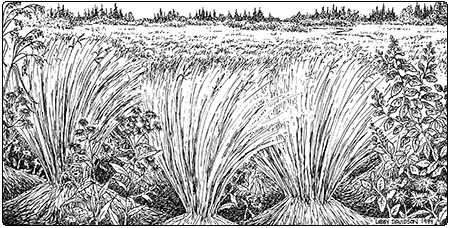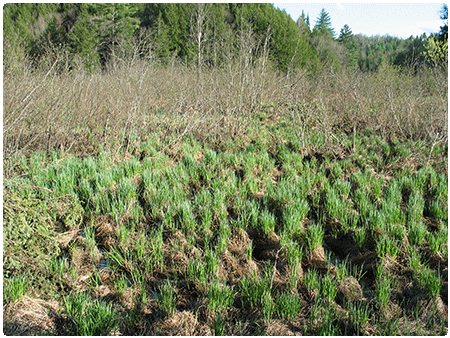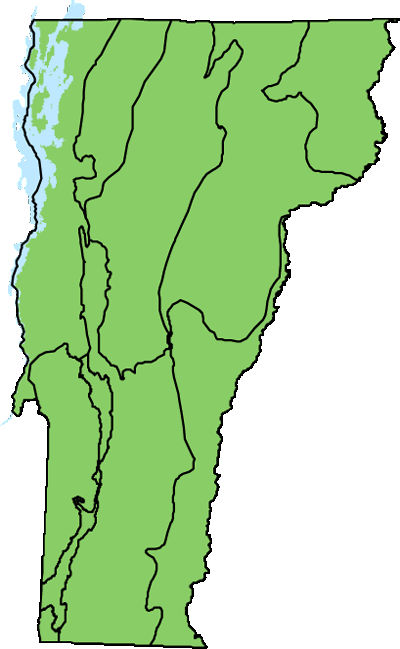Ecology and Physical Setting 
Sedge Meadows are common throughout Vermont. They occur in the floodplains of rivers and streams, and occasionally in isolated basins. Sedge Meadows tend to be part of larger wetland complexes and are frequently associated with Alder Swamps, Alluvial Shrub Swamps, and Shallow Emergent Marshes.
Sedge Meadows are permanently saturated and seasonally flooded. The soils are typically well-decomposed sedge peats, but Sedge Meadows also occur on mineral soils with a high organic content in the surface layers. The vegetation is firmly rooted in the organic or mineral substrate, and Sedge Meadows do not form floating mats when they are inundated.
 Historically, many Sedge Meadows were harvested for hay. This practice has declined because operating modern machinery on the wet and tussocky ground is difficult. In addition, the hay produced from sedge meadows is typically coarse and unpalatable to cows, and was used mostly as bedding.
Historically, many Sedge Meadows were harvested for hay. This practice has declined because operating modern machinery on the wet and tussocky ground is difficult. In addition, the hay produced from sedge meadows is typically coarse and unpalatable to cows, and was used mostly as bedding.
Vegetation
Sedge Meadows are commonly dominated by a single species of sedge, although several species may occur together as well. Tussock sedge is the dominant species in many wetlands, forming characteristic high mounds. These tussocks are the result of this sedge’s cespitose growth form and may provide the only dry, but unstable, stepping points for those venturing into these wetlands at high water. Other sedges that may dominate at particular sites or mix with one another include beaked sedge, blister sedge, bristly sedge, and the rare water sedge. Other herbaceous plants that are frequently found in this community include bluejoint grass, woolgrass, marsh cinquefoil, rice cutgrass, water horsetail, marsh spikerush, and three-way sedge.
Bryophyte cover is generally low. The species that do occur in Sedge Meadows cling to the upper sides of the tussocks, above seasonal flooding.
Wildlife Habitat
Sedge Meadows provide breeding and nesting habitat for swamp sparrows, marsh wrens, and the rare sedge wren. Rare marsh birds that may nest and feed in Sedge Meadows include American bittern and sora. Mink hunt for meadow voles, meadow jumping mice, and other small animals in Sedge Meadows associated with streams. Wood turtles are closely tied to streams and riparian areas and can be found foraging or basking in Sedge Meadows.
Tussock sedge is a primary host plant for four butterflies. One of these, the eyed brown, is widespread in eastern North America and common in Vermont. Three others—black dash, mulberry wing, and two-spotted skipper—are rare in Vermont.
Related Communities
- Intermediate Fen is dominated by woolly-fruited sedge and is fed by mineral-rich groundwater seepage or alkaline pond water. Fens have a diverse flora and a high percentage of bryophyte cover, and do not experience seasonal flooding. Pond-side examples of Intermediate Fens have a floating sedge-dominated mat.
- Shallow Emergent Marsh is drier and experiences less flooding, leading to greater plant diversity with more herbs and shrubs.
Conservation Status and Management Considerations
A few examples are protected on conserved lands, but this common community is often overlooked because it frequently occurs as small patches within a mosaic of other wetland communities. Because these are often found along rivers and streams, protecting riparian areas will benefit Sedge Meadows.
Distribution/Abundance 
This common community is found throughout Vermont and eastern North America.
Characteristic Plants
Shrubs
Occasional Species
Speckled alder – Alnus incana
Herbs
Abundant Species
Tussock sedge – Carex stricta
Beaked sedge – Carex utriculata
Blister sedge – Carex vesicaria
Occasional to Locally Abundant Species
Bristly sedge – Carex comosa
Lake sedge – Carex lacustris
Bluejoint grass – Calamagrostis canadensis
Woolgrass – Scirpus cyperinus
Marsh cinquefoil – Comarum palustre
Rice cutgrass – Leersia oryzoides
Canada mannagrass – Glyceria canadensis
Pointed broom sedge – Carex scoparia
Awlfruit sedge – Carex stipata
Fox sedge – Carex vulpinoidea
Flat-topped aster – Doellingeria umbellata
Purple-stemmed aster – Symphyotrichum puniceum
Water horsetail – Equisetum fluviatile
Marsh spikerush – Eleocharis palustris
Three-way sedge – Dulichium arundinaceum
Ditch stonecrop – Penthorum sedoides
Marsh bellflower – Campanula aparinoides
Non-Native Invasive Plants
Purple loosestrife – Lythrum salicaria
Bryophytes
Occasional to Locally Abundant Species
Moss – Sarmentypnum exannulatum
Moss – Drepanocladus aduncus
Moss – Plagiothecium denticulatum
Rare and Uncommon Plants
Water sedge – Carex aquatilis var. substricta
Foxtail sedge – Carex alopecoidea
Vasey’s rush – Juncus vaseyi
Associated Animals
Painted turtle – Chrysemys picta
Marsh wren – Cistothorus palustris
Swamp sparrow – Melospiza georgiana
Mink – Neovison vison
Meadow vole – Microtus pennsylvanicus
Meadow jumping mouse – Zapus hudsonius
Eyed brown – Satyrodes eurydice
Sedge sprite – Nehalennia irene
Cherry-faced meadowhawk – Sympetrum internum
Rare and Uncommon Animals
Eastern ribbonsnake – Thamnophis sauritus
Smooth greensnake – Opheodrys vernalis
Wood turtle – Glyptemys insculpta
Water shrew – Sorex palustris
Sedge wren – Cistothorus platensis
American bittern – Botaurus lentiginosus
Sora – Porzana carolina
Black dash – Euphyes conspicua
Dion skipper – Euphyes dion
Mulberry wing – Poanes massasoit
Two-spotted skipper – Euphyes bimacula
Places to Visit
Victory Basin Wildlife Management Area, Victory, Vermont Fish and Wildlife Department (VFWD)
South Bay Wildlife Management Area, Coventry, VFWD
